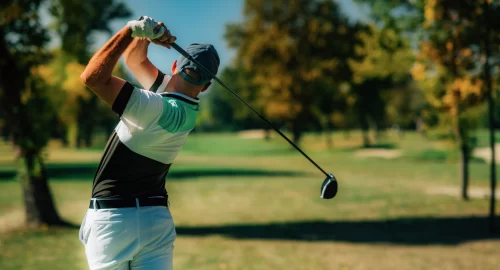
Many golfers struggle with consistently compressing their irons, leading to weak, high shots and a lack of distance. The ability to compress the ball effectively is a game-changer, providing better contact, improved trajectory, and more consistent shots.
Forbes-featured golf coach Eric Cogorno and Golf Digest Top 25 teacher Andrew Rice share their ball compression drill designed to help golfers achieve better compression with their irons in this easy-to-follow YouTube drill tutorial.
Understanding Golf Ball Compression and Impact
Compression is the key to consistent, powerful iron shots. You can think of ball compression as how much the golf ball “gives” when contacted by the golf ball. To achieve this, it’s essential to understand how the club should be positioned at impact.
Andrew Rice explains that at impact, the clubface should be slightly delofted, with the clubhead traveling slightly downward. This helps to expose the sweet spot to the back of the golf ball, allowing for better compression.
Professional golfers like Scottie Scheffler achieve this by converting the loft of their clubs significantly at impact, resulting in a stronger, more penetrating ball flight.
Common Mistakes in Golf Ball Compression
One of the most common issues golfers face is an open clubface during the downswing. This open face forces the golfer to compensate by flipping the club, leading to weak, high shots. The result is often thin or heavy strikes with compromised trajectory and distance.
The video highlights the importance of ensuring the clubface is in the correct position earlier in the downswing to avoid these issues in the golf swing.
The Tee Drill: A Simple Solution
To help golfers achieve better compression, Andrew Rice introduces a simple yet effective drill using a tee as a visual aid. The goal is to keep the tee pointing downward throughout the swing, indicating that the clubface is in the correct position. This drill helps golfers feel the correct positions in the swing and encourages the proper clubface alignment needed for compression.

Key Checkpoints in the Golf Swing
It’s important to take mental notes throughout the swing of some key checkpoints. In the takeaway, the clubface should be slightly closed, with the tee pointing downward. At the top of the backswing, the tee should point up and away from the golfer, avoiding an open clubface.
Dealing with Mis-Hits and Golf Swing Adjustments
As you work on this drill, you might initially experience low, left shots, especially if you’re used to an open clubface. However, this is a sign of progress, indicating that the clubface is closing earlier, which is necessary for compression.
Beginner and amateur golfers should focus on maintaining a square clubface through impact while minimizing compensatory movements, which lead to poor golf swing form.
Compress Your Irons Like a Pro
Compressing the golf ball is crucial for achieving consistent, powerful iron shots. By understanding the importance of clubface position and practicing drills like the tee drill, golfers can significantly improve their ball-striking ability.
For those looking to dive deeper into their game, consider our training videos like Square Strike System or Simple Strike Sequence to focus on ball striking and contact!

